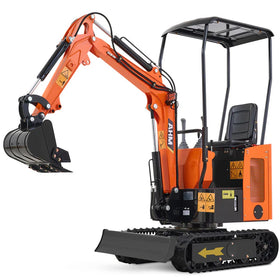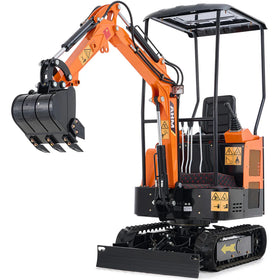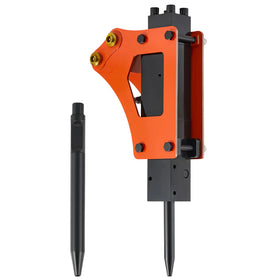Ever loaded your skid steer bucket and wondered if you're hauling the right amount or just wasting trips back and forth? How many yards is a skid steer bucket? It mainly depends on the bucket width and design, but getting this wrong will cost you in fuel, time, and unnecessary wear on your machine.
Standard skid steer buckets hold 0.5 to 1 cubic yard of material, with smaller buckets around 0.3-0.4 cubic yards and larger buckets reaching 1.5 cubic yards or more. The catch? That's just the bucket capacity - you also need to account for material weight and your machine's lifting capacity to avoid overloading and tipping. Sounds confusing? Let us clear your doubts!

How Many Yards Is a Skid Steer Bucket?
The answer to ‘How many cubic yards is a skid steer bucket’ varies based on the bucket width, depth, and design. This capacity will directly affect how efficiently you can complete jobs.
1. Standard Bucket Capacities by Width
Different bucket widths deliver specific capacity ranges that match skid steer size classes.
48-inch buckets:
- Capacity: 0.3-0.4 cubic yards
- Best for: Precise tasks like trenching and grading
- Applications: Confined spaces, landscaping work
- Typical use: Mini skid steers and compact loaders
60-inch buckets:
- Capacity: 0.5-0.6 cubic yards
- Best for: Versatile applications across multiple job types
- Applications: Material handling, light construction, general landscaping
- Typical use: Small to medium skid steers
72-inch buckets:
- Capacity: 0.7-0.8 cubic yards
- Best for: Construction, agriculture, and snow removal
- Applications: Moving larger volumes efficiently
- Typical use: Medium skid steers
84-96 inch buckets:
- Capacity: 0.9-1.5 cubic yards
- Best for: Heavy-duty excavation and large-scale material handling
- Applications: Site cleanup, moving materials in bulk
- Typical use: Large-frame skid steers with high lifting capacity
2. Understanding Struck vs. Heaped Capacity
How many yards a typical skid steer bucket gets calculated two different ways - struck capacity and heaped capacity.
Struck capacity (level capacity):
- Volume of material when the bucket is filled level of the top edge
- Calculated without any material heaped above the bucket edges
- Starting point for determining actual working capacity
- More conservative estimate for planning purposes
Heaped capacity:
- Volume when material is mounded above the bucket edges
- Represents real-world loading conditions in most applications
- Calculated as struck capacity plus additional heaped amount
- Formula: Struck capacity ÷ 3 = heaped amount, then add to struck capacity

How to Choose Your Skid Steer Bucket Size
When selecting how many yards of a standard skid steer bucket you need, make sure to match the bucket capacity to your machine specs and typical applications.
1. Match Bucket to Machine Operating Capacity
Your skid steer's rated operating capacity (ROC) limits how much weight you can safely lift. Operating capacity is 50% of the tipping load - the point where your machine tips forward.
Capacity guidelines:
- Small skid steers (under 1,750 lb ROC): 0.3-0.6 cubic yard buckets
- Medium skid steers (1,750-2,200 lb ROC): 0.6-1.0 cubic yard buckets
- Large skid steers (over 2,200 lb ROC): 1.0-1.5+ cubic yard buckets
Why matching matters:
- Too small buckets waste machine capacity and require extra trips
- Buckets that are too large will overload the machine, risking tip-overs and damage
- Choosing the wrong size increases fuel consumption and operating costs
- A proper match maximizes productivity per load cycle
2. Consider Material Density
Dense materials fill less volume but weigh significantly more than light materials. You need to account for this in bucket selection.
Light materials (can use larger buckets):
- Snow, mulch, wood chips
- Allow maximum bucket capacity usage
- Volume matters more than weight
Heavy materials (require smaller buckets or partial loads):
- Wet clay, asphalt, and concrete
- Weight limits bucket fill amount
- Must calculate the total load to avoid overloading
3. Factor in Bucket Width Requirements
Bucket width should exceed your skid steer's wheel or track width to prevent driving over material you just moved.
- Choose buckets 2+ inches wider than wheelbase
- Prevents compressing material on the outside of the bucket
- Improves efficiency in grading and snow removal
4. Account for Bucket Weight
Heavy-duty buckets can weigh over 1,000 pounds, significantly reducing the lifting capacity of smaller skid steers. The bucket weight counts against your total load capacity.
- Light-duty buckets: 200-400 pounds
- Standard buckets: 400-700 pounds
- Heavy-duty buckets: 700- 1,000+ pounds
- Specialty buckets (4-in-1, grapple): Can exceed 800 pounds
5. Application-Specific Selection
Different jobs require different bucket types and capacities to get the optimal results.
For general material handling:
- Standard 60-72 inch buckets work for most applications
- 0.6-0.8 cubic yard capacity balances productivity and control
- Versatile across dirt, gravel, and mixed materials
For snow removal:
- Wider, higher-capacity buckets (0.8-1.5 cubic yards)
- Light material density allows maximum volume usage
- Width matters more than depth for coverage
For precision work:
- Smaller buckets (0.3-0.5 cubic yards)
- Better control in tight spaces
- Reduced risk of overloading on dense materials
For heavy construction:
- Match the bucket to the heaviest typical material
- Calculate load weight for worst-case scenarios
- Prioritize durability over maximum capacity

Affordable Skid Steer Bucket from AHM
The AHM 41-inch 4-in-1 combo mini skid steer bucket delivers versatile performance with 5 cubic feet (0.185 cubic yards) capacity that handles multiple applications without the need for attachment changes. This multipurpose bucket combines the standard bucket, dozer blade, clamp, and scraper functions in one tool, making it the go-to attachment for contractors who need flexibility without the hassle of swapping equipment mid-job.
Capacity and performance specs:
- 5 cubic feet (0.185 cubic yards) volume to handle substantial material loads
- 110° maximum jaw opening angle
- 240-pound load capacity
- 40.6-inch dozer blade width for efficient grading work
- 303.8-pound net weight leaves room for material on mini skid steers
Four-function versatility:
- Standard bucket mode for digging and material loading
- Dozer blade function for grading and leveling surfaces
- Clamp operation for gripping debris and irregular materials
- Scraper capability for back-dragging and surface preparation
Installation and compatibility:
- Quick-attach coupler for fast, secure mounting
- Hydraulic hoses included for clamp function operation
- Universal mount works with AHM and compatible skid steer brands
- Supports both regular and hydraulic attachment methods

Final Thoughts on Skid Steer Bucket Weight
How many yards is a skid steer bucket ranges from 0.3 cubic yards for compact 48-inch buckets to 1.5+ cubic yards for large 84-96 inch models. Most contractors get maximum efficiency from standard 60-72 inch buckets holding 0.5-0.8 cubic yards that balance capacity with machine limitations.
Always match your bucket capacity to your machine's operating capacity, account for material density, and choose a width that covers your wheelbase. This smart approach keeps you productive without risking tip-overs or wasted trips.







